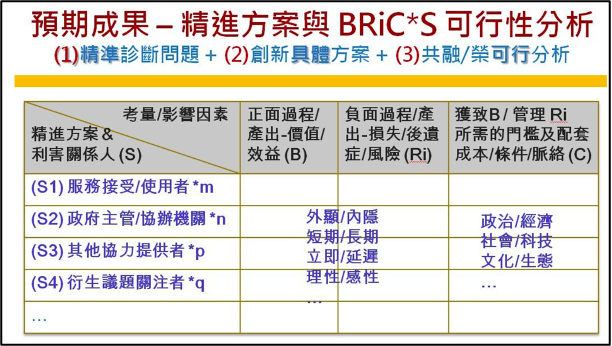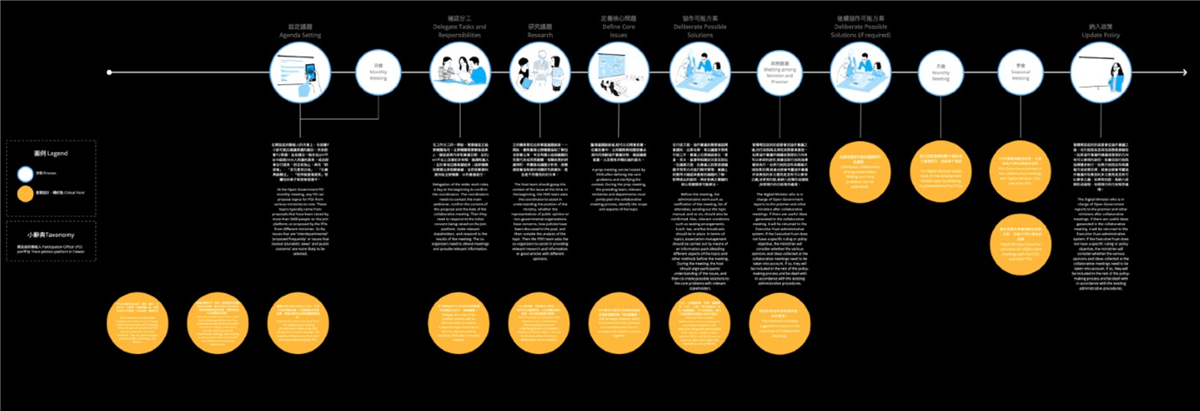There are many ways to practice open government, and collaborative meetings are just one of them. "Collaboration" is aimed at a certain issue. Everyone has different ideas and goals, but they all want to contribute. So everyone discusses, listens to each other, tries to find common ground, and come up with solutions.

Set agenda>>Monthly meeting discussion>>Confirm division of labor>>Research agenda>>Definition of core issues>>Government meeting>>Possible directions for follow-up collaboration>>Monthly meeting discussion>>Quarter meeting discussion>>Inclusion policy
Collaboration meetings are different from traditional public hearings and briefings by government departments in that we emphasize that the public and private sectors work together to develop a core issue suitable for discussion, and introduce hosting technology and technological tools to ensure that the meeting conforms to the spirit of open government.
The Open Government Contact Person (PO) is the soul role in the collaboration meeting, responsible for translating the needs of different actors and building a bridge of communication.
In the process of collaboration, everyone has different philosophies and goals. The public is not just monitoring and criticizing, and the government is not just defending existing positions. Everyone has to work together to find a solution to the problem. In the end, it may not be possible to reach a complete consensus, but to achieve the result of "although the output of the meeting is not the result I want most, but it does not violate my philosophy and is acceptable"
- Make public hearings more "open"
- Bring people with complex policies and conflicts of interest together for discussion
- The government builds a platform for mutual understanding between opposing parties
- Make the digital service process more usable
- Open Government Project 13 Collaboration Conference "National Gradual Prohibition of Disposable Tableware" Joint Signature Case
- Open Government Project 79 Collaborative Conference "Motorcycle Exhaust Exhaust Regular Inspection Improvement Program" self-proposed by the department

- Addressing the Democratic Deficit
- Increase civic engagement
- Reduce the fatigue of public servants
- Breaking the barriers of time and space
- Anonymity, code name, eliminate identity label
- Easier to express diverse viewpoints
- Highly interactive
- Tax filing platform reform
- Mask map
- Touqianxi project
- BRiC*S Feasibility Analysis Form: Provide refined solutions and problem analysis tools
- Video conferencing: Teams, Google Meet, Jitsi (open source software), BigBlueButton (open source software)
- Paper collaboration: Google doc, HackMD
- Online interaction: miro (online meetings, sticky notes, mind maps), slido (anonymous questions)

At the monthly meeting of the open government liaison, POs of all ministries can propose topics to be voted on for votes by POs of all ministries. These topics generally come from proposals seconded by more than 5,000 people on the Join platform, or are proposed by the ministry itself. So far, cases with attributes such as "inter-departmental committees", "diversity of opinions", "public opinion concern", and "repeated proposals" are easier to be selected.
At the beginning of the work division, it is necessary to confirm the main co-organizer. The organizer needs to contact the proposer, confirm the content of the proposal and the meeting date, and respond to the preliminary schedule on the Join platform, invite seconders, and respond to the meeting results after the meeting; the co-organizer needs to attend relevant meetings and provide relevant information to Organizer to facilitate the meeting.
The host team should grasp the context of the topic at this time. At the beginning, the team will ask the host organization to help understand the position of the ministry, whether there are representatives of public opinion or civil society concerned about this issue, and the research and discussion of relevant policies, and then compile it into an issue analysis table, and then ask the ministry to assist in providing relevant research and information. data, and even opinions of differing opinions.
Source: https://po.pdis.nat.gov.tw/zh-TW/meeting-process/
After clarifying the context of the topic, a pre-meeting meeting can be held. In the pre-conference meeting, the host team and relevant departments must jointly plan the collaborative meeting process, confirm the scope of the topic, and focus on the aspects of the discussion.
In terms of administration, before the collaborative meeting, it is necessary to confirm the administrative work such as the meeting notice, the attendance list, and the mailing of the agenda manual. At the meeting, it is also necessary to confirm whether the seats, lunch boxes, tea, live broadcast, etc. are in place. In terms of topics, expectancy management should be carried out through the topic manual and other methods before the meeting. During the meeting, it is necessary to reconfirm the participants' understanding of the topic, align each other's cognitions, and then aim at the real key core issues and come up with possible solutions.
The political committee that oversees the open government reports to the Premier and other political council members after the collaborative meeting. If there is a part that can be participated in the direction suggested or thought by the collaboration meeting, it will be returned to the command system of the Executive Yuan for implementation. If the Executive Yuan does not have specific rulings or policy goals, the ministry will consider whether the diverse opinions collected at the collaborative meeting can be used for reference. If so, it will be included in the policy formation process and dealt with in accordance with the current administrative procedures. .

Miro is a digital tool for virtual whiteboards, which can visualize issues and make it easier for teams to collaborate online. In collaborative meetings, the functions of post-it notes and mind maps are most commonly used, which can be used as a way to analyze issues and organize information when interviewing stakeholders. Currently, web version, computer version App and mobile app are available. , you can easily use Google, Apple ID, Facebook account to log in for free
slido is a digital tool of an "online interactive system". In collaborative meetings, the moderator and participants can communicate anonymously without having to log in with an account.

| Update Date: | 2025/11/12 |


